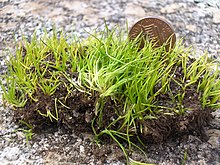Bream-like
| Bream-like | ||||||||||||
|---|---|---|---|---|---|---|---|---|---|---|---|---|

Sea bream ( Isoetes lacustris ) |
||||||||||||
| Systematics | ||||||||||||
|
||||||||||||
| Scientific name | ||||||||||||
| Isoetales | ||||||||||||
| Prantl |

The bream-like (Isoetales, also written Isoëtales) are an order of the bear moss plants . The bream herbs ( Isoetes ) are the only living genus . Fossil is the order known since the Devonian .
features
The representatives are approximately herbaceous plants . The main distinguishing criterion to the related orders is the structure of the rhizomorph , which is here bilaterally symmetrical. The leaves have a ligula . The sporophylls are grouped on the stem axis in a fertile region. You are heterosexual .
Systematics
In addition to the only recent genus of bream herbs , the following extinct forms are counted among the Isoetales:
- Clevelandodendron ohioense (Upper Devonian )
- Wexfordia hookense (uppermost family )
- Otzinachsonia beerboweri (Famennium)
- Chaloneria cormosa ( Carboniferous )
- Porostrobus (cones from the Carboniferous, possiblybelongingto Chaloneria )
- Sporangiostrobus (carbon)
- Nathorstiana ( chalk )
- Nathorstianella (chalk)
- Isoetites ( Triassic to Cretaceous)
Some authors summarize all Bärlapp groups with rhizomorphs in the order Isoetales, which then also includes the families of the Lepidodendrales .
Fossil history
The Isoetales have been known as fossils since the Devonian. This means that the thesis that Isoetes developed in a reduction series from tree-shaped club moss plants is no longer tenable. The discussed transitional forms Pleuromeia and Nathorstiana are significantly younger than the oldest Isoetales.
Fossils, which already closely resemble the recent bream herbs, are already known from the Triassic and are listed as Isoetites . A small plant with up to 7 cm long leaves from the Triassic of China is placed as Isoetes ermayinensis in the recent genus of bream herbs ( Isoetes ).
supporting documents
- Thomas N. Taylor, Edith L. Taylor, Michael Krings: Paleobotany. The Biology and Evolution of Fossil Plants . Second Edition, Academic Press 2009, ISBN 978-0-12-373972-8 , pp. 320-325.
Individual evidence
- ^ William A. DiMichele, Richard M. Bateman: The Rhizomorphic Lycopsids: A Case-Study in Paleobotanical Classification . Systematic Botany, 1996, Vol. 21, pp. 535-552.